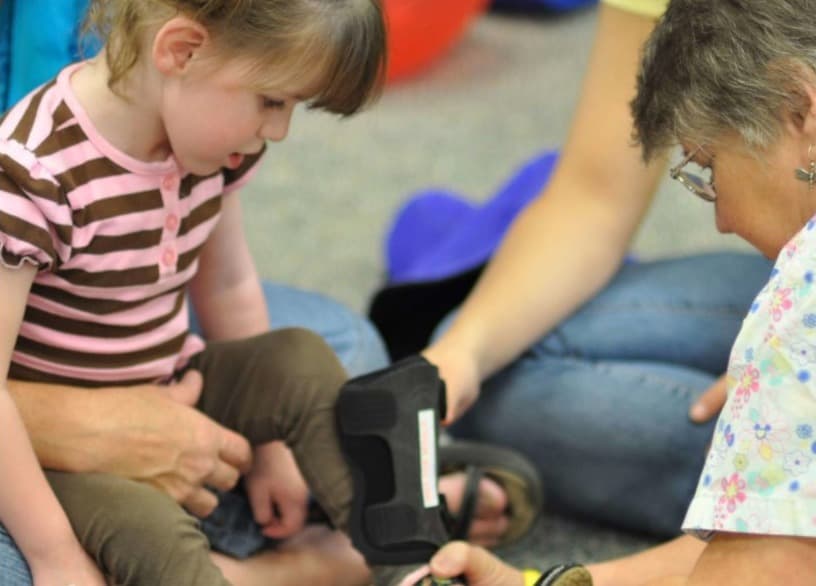Short History of SPIO
by Nancy Hylton, PT,LO
SPIO Lycra Compression, emerged in 1994, through a collaboration of parent, Cheryl Allen and therapist, myself, following several years of experience using Neoprene compression to improve active stability and balance and reduce disruptive hypertonus to improve movement control children at Children’s Therapy Center of Kent in Washington State. Cheryl was a gifted and creative seamstress and parent to 2 adopted boys with significant early sensory-motor deficits, who responded positively in therapy to manual deep pressure and vibration input during therapy sessions. Cheryl
explored elastic materials by making a new pair of little compression pants for her son every week, finally exclaiming “Nancy, I found it” as Bryan walked into therapy, not on his tiptoes, able to balance and grade movement through squat while wearing these shiny black pants. I could even place little vibrators in the pants against gluteals and begin challenge balance over 1-leg.
Cheryl’s second son, Ian, had much bigger sensory and movement deficits and began in therapy under 2 months with strong opisthotonic posturing and severe irritability following neonatal pertussis and drug/alcohol exposure. Beginning at 10 months of age, his motor response to an SPIO Lycra suit astounded us all and enabled him to learn to sit, pull to stand, cruise, and walk independently by 20 months of age. At about the same time, Cheryl was able to make Double-layer lycra vests for 4 young children with severe quadriplegia, who had been successfully wearing Benik Neoprene vests to improve, active head, trunk, and limb control. Much to our surprise, the SPIO Lycra vests worked better for all of these children and were much more comfortable to wear.

So clinical observation necessitated a deeper query into why we were seeing these sometimes immediate and remarkable improvements in active motor control and
balance. My ideas about Neoprene compression improving dynamic joint and soft tissue stability were too limited. Something was happening to deep sensory body awareness that was improving the neural foundation for movement control. Learning the relationship between Proprioception, Deep Pressure, Precise Touch, and Vibratory inputs at a course began to clarify my understanding and has been increasingly verified over the past almost 30 years of clinical experience with the use of SPIO as a helpful therapeutic intervention tool.
How Does SPIO Work?
The current understanding is that SPIO provides primarily enhanced deep pressure receptor activation, which does not adapt over time, because small changes in body position continue to activate different receptors. This input feeds into the cortical 3-D sensory body map, which is foundational for both active intentional movement control and Central Pattern Generation and Ribbon Generation for reciprocal movement, posture, stability, and balance. Activation of these systems secondarily impacts joint and muscle proprioceptors to improve the grading of movement and active motor control. Because muscle hypertonus is and soft tissue tension is primarily compensation for decreased dynamic stability and poor sensory body awareness, rapid and sustained tone reduction can also often be seen with SPIO wear. Somewhat counter-intuitively, hypotonia and biomechanical instability also respond very positively to SPIO compression to improve active stability, balance, and grading/timing of movement.
The combination of high even multi-directional elasticity and very high rebound memory with SPIO are responsible for these clinical effects and that they can be worn throughout the day with no diminishment of positive therapeutic effect. Deep pressure, proprioception, precise touch, and vibratory receptors are all mechano-receptors dependent on minute changes in position to activate properly. Very intimate fitting, highly flexible, orthotic systems are, therefore, much more able to provide typical afferent input upon which neuro-motor mechanisms are dependent.

